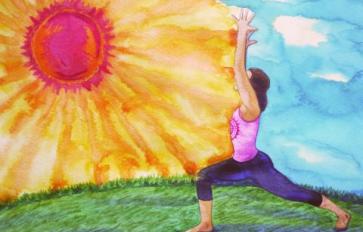
Middle school, defined as the 7th and 8th grades, is a time period in which children have an increased risk of starting habits such as smoking cigarettes and trying other chemical substances. A previous study showed that 3-10% of middle schoolers in the United States used cigarettes, alcohol, or illegal drugs. Thus, researchers wanted to see if yoga practice could lower the desire of middle school students to use substances.
Middle school students from a school in Boston, MA, participated in this study. This school had a graduation rate of 98.9% in 2013-2014, and all students had to place above a certain score on a standardized exam in order to attend the school. 77 of the participants were male (36.8% of the total) and 132 were female (63.2% of the total). These students were primarily White and Asian.
The students were randomly assigned to either a yoga class or the usual physical education (PE) class. 116 students did yoga and 93 did the usual PE. The yoga class met 1-2 times per week for six months.
A typical yoga session contained the following segments (with some variation from class to class): centering and breathing exercises (~5 min), warm-ups, (~5 min), yoga poses (~15 min), didactic/experiential content (~5 min), and relaxation (~5 min). Commonly practiced poses included warrior I, warrior II, triangle, sun salutations, integrative twist, and legs up the wall. Each session built upon the previous sessions and introduced new postures as the curriculum progressed.
Sample breathing techniques included ocean breath (i.e., breathing through the nose while slightly constricting the esophagus), alternate-nostril breathing (i.e., breathing in through one nostril and out the other), and 3-part breathing (i.e., deep diaphragmatic breathing moving from the abdomen to the solar plexus and upper chest). Didactic and experiential content often encouraged social interaction (e.g., peer-to-peer listening, group discussion, students leading poses) or activities for self-discovery (e.g., holding a posture beyond initial resistance, journaling about ways to de-stress).
Students were surveyed at four time points: the start of the program, the end of the program, six months later, and 12 months later. The surveys measured various mental and emotional states, including mood, perceived stress, impulsiveness, self-control, substance use willingness, and actual substance use.
The results showed that after practicing yoga for six months students were less willing to try smoking cigarettes, compared to students who did the usual PE for six months. An effect of yoga was seen 12 months after the program was completed, but only in the female students. These female students reported improved self-control a year after completing the yoga program. Interestingly, the usual PE group also showed an improvement in self-control one year after the program, but only in male students.
Reference
Butzer B., LoRusso A., Shin S. H., and Khalsa S. B. “Evaluation of Yoga for Preventing Adolescent Substance Use Risk Factors in a Middle School Setting: A Preliminary Group-Randomized Controlled Trial.” Journal of Youth Adolescence. 2016, May 31.








